
Diffuse sound fields – calculate right!
Some years ago Saint-Gobain Ecophon published a new tool for calculating room acoustics. The tool makes it possible for the user to see both Sabine calculations on reverberation time, speech clarity, and room gain. It makes it possible for the user also to see calculations based on air flow resistivity (AFR). Read more about the background of the tool here.
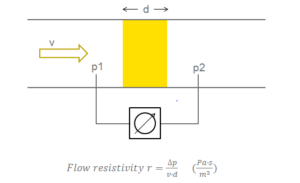
The Sabine formula is used for the calculation of reverberation times under the assumption of a diffuse sound field. But in rooms where the main part of the absorption is located in the ceiling, e.g. as a suspended sound-absorbing ceiling, the diffuse sound field is not valid and the assumptions for the Sabine formula are not fulfilled. This is why the tool has included calculations based on AFR – to make it possible to also predict room acoustics in rooms that have non-diffuse sound fields.
The model also considers furnishing because we know that it affects room acoustics a lot. In the tool, you can therefore choose between sparse, normal, and dense furnishing. The acoustic effect of furniture is quantified in the measure equivalent scattering absorption area Asc . The values are given for the furniture configurations corresponding to sparse, normal, and dense.
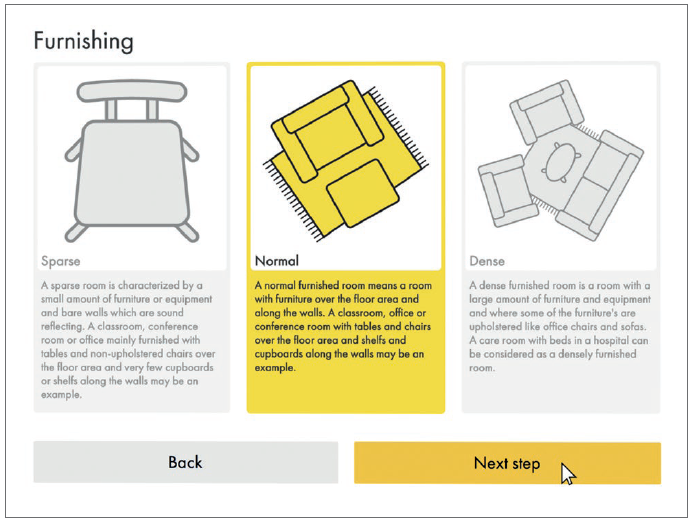
Finally, the model makes it possible to choose different kinds of background absorption properties for walls, soffits, floors, windows, and doors. The choices are motivated by the relatively small influence of this absorption compared to the influence of the sound-absorbing ceiling, wall absorbers, and furniture. The selected material covers what is typically encountered in practice.
But – when is it correct to rely on the Sabine calculations – the diffuse field solution? And when is it correct to rely on the calculations for the non-diffuse sound field calculated with AFR? What input data could be the tipping point? Amount of absorption? Scattering effect of furniture?
We have tried to look into WHEN a room is considered to be diffuse or non-diffuse by both measuring the rooms, doing Odeon simulations, and doing the calculations in the Ecophon Acoustics Calculator (called EAC).
Gentofte Hospital, audiometric rooms
At Gentofte Hospital an intervention study was done to see if it was possible to design the room to make it suitable for carrying out audiometry tests on children aged 0-6 years. The client’s wish for the room was to get as close to free field conditions as possible – down to 250 Hz. Read more about the project here.
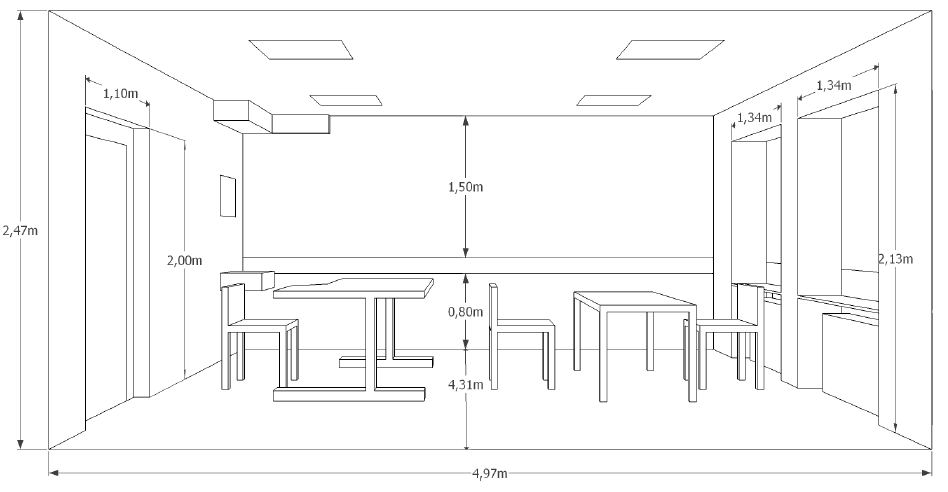
An office with a suspended metal ceiling was chosen for the intervention. It was a three-step intervention:
- Step one: The original ceiling (the original room had a suspended metal ceiling)
- Step two: The ceiling was changed into a class A glass wool porous absorber + Extra bass absorber
- Step three: Acoustic wall panels – also glass wool absorbers, were mounted on two walls.

At steps one and two the room was considered to be non-diffuse, and the simulations and measurements did not differ much from the EAC calculations based on AFR (only step two was evaluated in EAC). This is a textbook example of a rectangular smaller room with sparse furnishing and absorption on one surface only: a non-diffuse sound field.
But when the room was altered in step three, the picture looked very different. The room was again altered acoustically and acoustic wall panels now fully covered two walls in the room. Now the calculations for T20 with AFR did (the ‘Ecophon’ columns) not match the actual measurements (the ‘Dirac’ columns) and simulations (the ‘Odeon’ columns); the room could be calculated with Sabine.
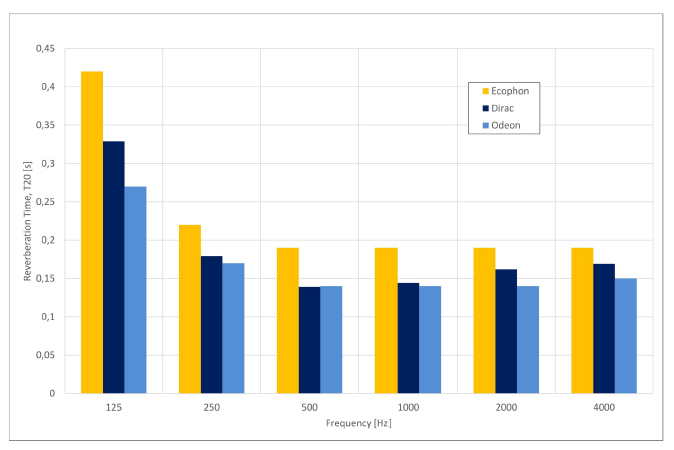
In this room, the furnishing was sparse and didn’t do much in regards to the diffusion of the room. But the amount of absorption in step three and the distribution of it did a lot! With this example in mind, one could say that if you have both an acoustic ceiling and fully covered walls (min. two) the calculation method could ‘switch’ from AFR-based to Sabine.
Århus University Hospital, dementia clinic
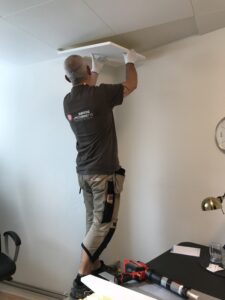 Another example of when to use what calculation method is seen in a dementia clinic in Århus, where the acoustics were altered. This time it was only one step – from the original plasterboard ceiling to a glued solution with a porous glass wool absorber. Read more about the project here.
Another example of when to use what calculation method is seen in a dementia clinic in Århus, where the acoustics were altered. This time it was only one step – from the original plasterboard ceiling to a glued solution with a porous glass wool absorber. Read more about the project here.
The room was not a traditional squared box but had many angles and irregularities. Two of the walls were of concrete and bricks and the rest were made of gypsum. The furnishing was dense and had both a patient bed, bookshelves, tables, and chairs. On top of this, the room was small.
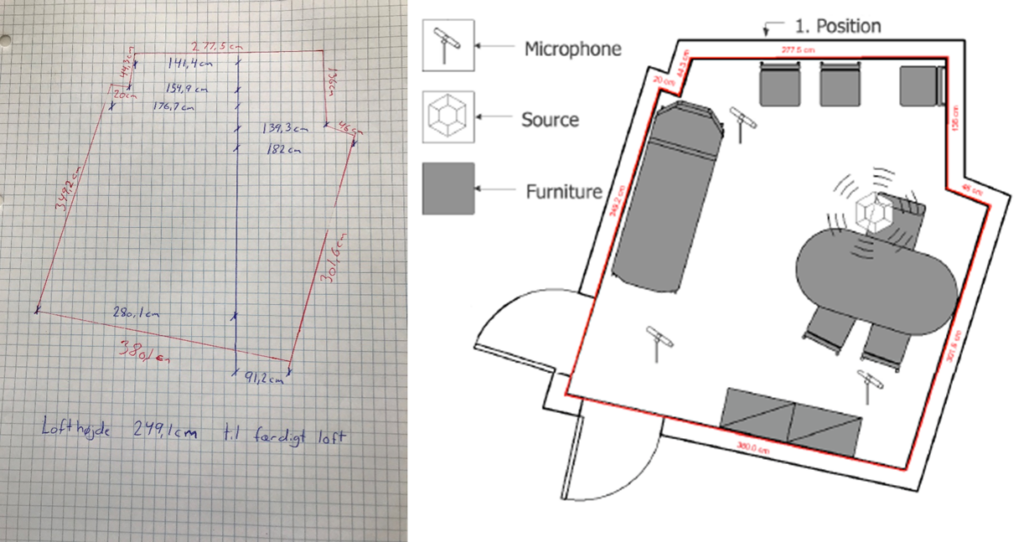
Normally, one would consider this room – with absorption on one surface only (ceiling) to be classical non-diffuse, and calculations with Sabine would not normally reflect reality, which means that calculations with AFR should be considered. But in this case, the room geometry, surfaces, and dimensions PLUS the dense furnishing might prove us wrong since the results showed that the calculations with Sabine were closer (?) to the in situ measurements than the calculations with AFR:
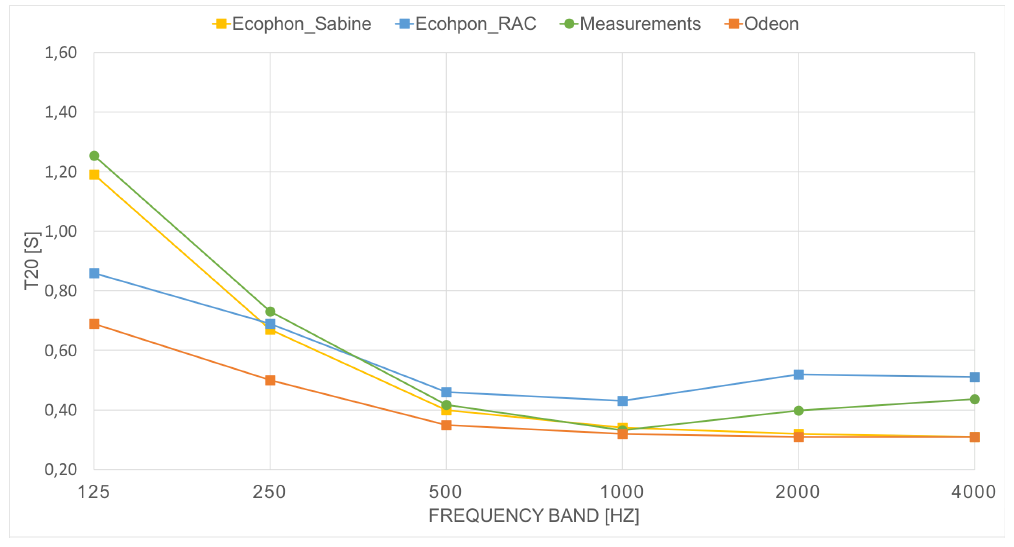
In this case, it is really hard to choose what calculations (Sabine or AFR) to consider ‘most correct’ in comparison to the measurements. The Sabine follows the measurement curve very well all the way but also the AFR curve follows the measurement very well from 250 Hz and up.
So – what is a diffuse sound field in reality? Does it exist? Normally a diffuse sound field needs the circumstances we have in reverberation chambers (large volume, low mean absorption, and uniformly distributed absorption).Even under these circumstances, it’s tricky to get a diffuse sound field.
Can we predict what calculation method that is best in any case? These above examples show that we need to consider the amount of absorption, the distribution of absorption, the background absorption parameters, the geometry of the room, AND the furnishing before we chose the calculation method. But we also know that if we have a ‘normal squared box’ with absorption on one surface only, then Sabine is often not sufficient.
Borås hospital, patient ward
In this study, the acoustics of a patient ward was changed from reflective plasterboard ceilings to acoustic class A glass wool ceilings. The furnishing was considered to be dense but the background absorption was hard material (brick, concrete). Also, the rooms in the study were perfectly rectangular and quite large; 77m2. Read more about the study here.
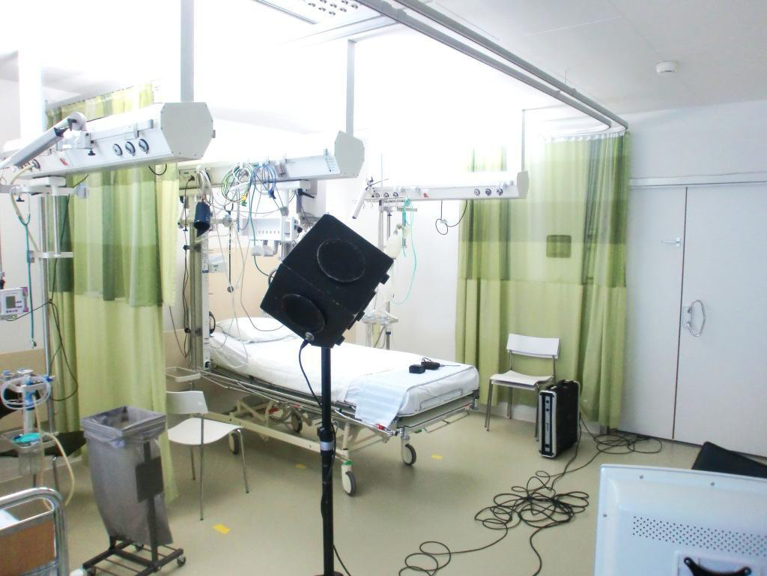
In this case, despite the dense furnishing, one would predict this room to be non-diffuse and the calculation method should therefore be based on AFR and not Sabine.
In this example, we don’t have Odeon simulations but we do have in situ measurements to compare the calculations with. The results were as follows. (NB. Measurements with Dirac software – blue curve, calculations in EAC based on Sabine – green curve, and calculations based on AFR – red curve).
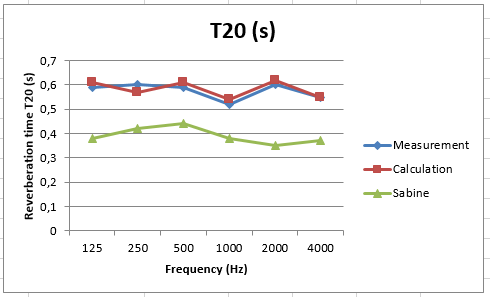
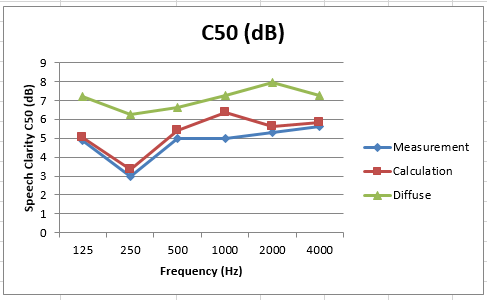
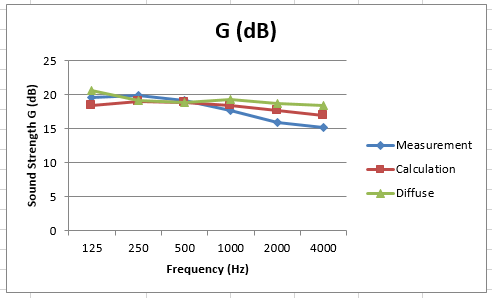
In this case, we see the best match between the measurements and the calculations based on AFR. The Sabine calculation is very far from reality on both T20 and C50 in this case. Gain is not affected much by the calculation method which has to do with the amount of absorption more than the diffusion (or the opposite) of the room.
This last example shows that IF we have a large squared/rectangular room with absorption on one surface only (and low background absorption) – even with dense furnishing we don’t have a diffuse sound field and the calculation method should not be based on Sabine.
Prediction of room acoustics?
According to the mentioned three cases, we often can predict what calculation methods to rely on but we also need to keep in mind that sometimes it is tricky! The predictions of room acoustics before a building is done or a refurbishment is made will continue to develop as models and software get better and better. Who wouldn’t love values for Dl2 in an open office before it is built?
_________________________________
NB. More detailed information about the EAC model is to be found below in [1]. The development has been conducted in close cooperation with the Technical University of Denmark (DTU) [2], [3].
1) Nilsson E. Input data for acoustical design calculations for ordinary public rooms, ICSV24, July 2017, London
2) G. Marbjerg, J. Brunskog, C.-H. Jeong, and E. Nilsson, Development and validation of a combined phased acoustical radiosity and image source model for predicting sound fields in rooms, J. Acoust. Soc. Am. 138, 1457–1468 (2015).
3) Bakoulas Konstantinos, Optimization of an energy-based room acoustics model that considers scattering and non-uniform absorption, Master thesis, Department of Electrical Engineering, Technical University of Denmark, July 2017

